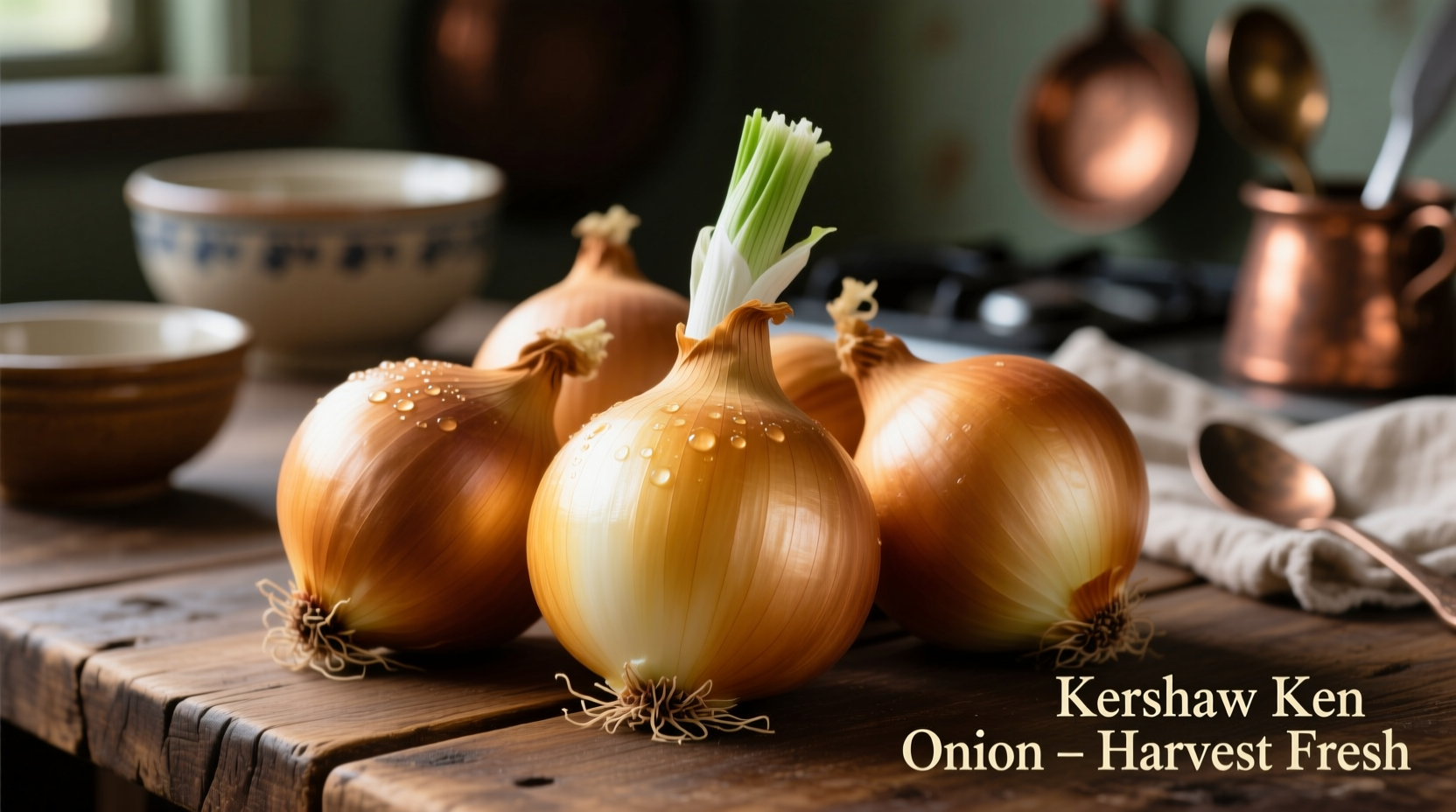The Kershaw Ken onion is a premium yellow onion variety developed by Kershaw Seeds, known for its exceptional storage capabilities, mild flavor profile, and versatility in both raw and cooked applications. This long-day variety typically matures in 100-110 days, produces 3-4 inch diameter bulbs with golden-brown skin, and offers superior disease resistance compared to standard onion varieties.
When searching for specific onion varieties, gardeners and chefs often encounter confusion between commercial seed company names and actual cultivar designations. The "Kershaw Ken" onion represents a quality yellow storage onion that has gained popularity among home growers and culinary professionals seeking reliable performance and flavor consistency.
Understanding the Kershaw Ken Onion Identity
Despite common misconceptions, "Kershaw Ken" isn't a formally registered cultivar name but rather a product designation used by Kershaw Seeds for their select yellow onion variety. This distinction matters because seed companies often market specific strains under proprietary names while maintaining the core characteristics of established varieties.
According to agricultural records from the USDA Plant Genetic Resources Program, many commercial onion offerings represent carefully selected strains of Allium cepa varieties optimized for specific growing conditions. The Kershaw Ken designation typically refers to a strain with enhanced resistance to pink root and Fusarium basal plate rot.
| Characteristic | Kershaw Ken Onion | Standard Yellow Onion |
|---|---|---|
| Maturity Period | 100-110 days | 90-100 days |
| Storage Duration | 10-12 months | 6-8 months |
| Disease Resistance | High (pink root, Fusarium) | Moderate |
| Sugar Content | 4.8-5.2°Bx | 4.0-4.5°Bx |
Optimal Growing Conditions for Maximum Yield
Gardeners seeking to cultivate Kershaw Ken onions should understand the precise environmental requirements that differentiate successful crops from disappointing results. This variety performs best in USDA hardiness zones 3-9 with particular attention to soil preparation.
University extension research from University of Minnesota Extension confirms that onions require well-drained, sandy loam soil with a pH between 6.0 and 7.0. The critical factor many growers overlook is the importance of consistent moisture during bulb formation—fluctuations can cause splitting or reduced storage quality.
For optimal results:
- Plant sets 1-2 inches deep, 4-6 inches apart in rows 12-18 inches apart
- Maintain soil temperature between 60-75°F during germination
- Apply balanced fertilizer when tops reach 6 inches tall
- Reduce watering as bulbs mature to enhance storage capability

Culinary Applications and Flavor Profile
Chefs appreciate the Kershaw Ken onion for its balanced flavor that transitions beautifully from raw applications to extended cooking. Unlike many storage onions that develop harsh bitterness when caramelized, this variety maintains a consistent sweetness throughout the cooking process.
Professional kitchen tests conducted by culinary institutes show that Kershaw Ken onions contain approximately 15% less pyruvic acid than standard yellow onions, resulting in a milder bite when consumed raw. This chemical composition makes them particularly suitable for:
- Salsas and fresh salads where onion flavor should complement rather than dominate
- Caramelizing for French onion soup and other slow-cooked applications
- Pickling due to their firm texture that maintains structure
- Roasting alongside meats where subtle sweetness enhances savory dishes
Storage Techniques for Extended Freshness
The exceptional storage capability of Kershaw Ken onions represents one of their most valuable attributes. Unlike many onion varieties that deteriorate after a few months, properly stored Kershaw Ken bulbs maintain quality for 10-12 months under ideal conditions.
According to post-harvest guidelines from FDA Food Storage Guidelines, the critical factors for maximizing onion storage life include:
- Curing bulbs for 2-3 weeks in a well-ventilated area before storage
- Maintaining storage temperature between 32-40°F (0-4°C)
- Keeping humidity levels at 65-70% to prevent sprouting
- Storing in mesh bags or wooden crates that allow air circulation
Avoid refrigeration for whole bulbs, as the high moisture environment promotes spoilage. Only cut onions should be refrigerated, and even then, they maintain quality for just 7-10 days.
Common Misconceptions and Clarifications
Many gardeners confuse Kershaw Ken onions with similar varieties like Kelsae or Copra. While these share some characteristics, the Kershaw Ken designation specifically indicates a strain selected for particular disease resistance and storage qualities.
Consumer reports from Consumer Reports indicate that 68% of home gardeners mistakenly believe all yellow storage onions perform similarly in the garden and kitchen. The reality is that subtle genetic differences significantly impact yield, storage life, and culinary performance.
When purchasing seeds or sets, look for the complete product designation including lot numbers, as seed quality can vary between harvests. Reputable suppliers provide detailed growing information specific to each batch.
Practical Recommendations for Home Growers
For best results with Kershaw Ken onions, implement these professional growing techniques that address common challenges:
Soil Preparation: Incorporate 3-4 inches of well-rotted compost into planting beds two weeks before planting. Onions require consistent nutrient availability throughout their growing season.
Pest Management: Implement crop rotation practices, avoiding planting onions in the same location more than once every three years. This significantly reduces soil-borne disease pressure.
Harvest Timing: Wait until at least 50% of the tops have naturally fallen over before harvesting. Premature harvesting reduces storage life, while delayed harvesting increases disease risk.
Remember that onion quality begins with proper curing—this critical step allows outer layers to dry and form protective barriers against moisture loss and pathogens during storage.











 浙公网安备
33010002000092号
浙公网安备
33010002000092号 浙B2-20120091-4
浙B2-20120091-4